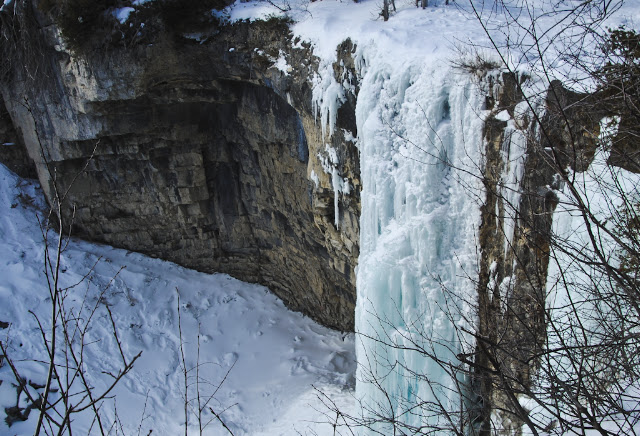I've always enjoyed chasing waterfalls, and for a year or two back in 2015/16/17 those were almost the only winter photos I took. We're blessed by having a surprising number of waterfalls around, all thanks to the bedrock of the Niagara Escarpment.
This is the best known of them, Inglis Falls, just on the south edge of Owen Sound. I'm told that my great-grandfather used to bring his grain to the mill here, to get it ground into flour for the winter. It's half or more frozen in this photo, and a truly beautiful falls all year round.
A little harder to access, requiring a hike of a mile up a narrow valley, is Indian Falls. It's a classic geologically, falling over a thin-bedded dolomite layer into the softer Queenston Shale, which accounts for the narrow, steep-sided ravine you have to hike up to get there. The normal view is from the top, but one year of exceptionally cold temperatures, enough of the stream below froze over to allow you to hike up to see the falls from below. It became a local hit, with crowds braving the cold to see the very icy waterfall! Maybe you can see the footprints in the first photo.
Hoggs Falls is much closer to our former home. Right in the heart of the upper Beaver Valley, it was once the home of an early power house for the nearby village of Flesherton, run by you guessed it, Mr. Hogg. In summer you can clamber down to see it from below, but I wouldn't dare do that in winter.!
This was my first view of Stew Hilts Falls 10 years ago, when I hiked off the Bruce Trail to assess the idea of putting a side trail here. You can read the geology here easily. It falls over that narrow-bedded dolomite, the Manitoulin Formation, but quickly into the Queenston Shale which has eroded into these extremely steep slopes.
A few years later and a side trail was actually created, enabling hikers to see this tiny gem. It's much better seen in the winter when these ice columns form - but that does require snowshoes to get here. I had nothing to do with the side trail being named the Stew Hilts Side Trail. And by default the little un-named waterfall became the Stew Hilts Falls. I'll happily go to my grave knowing there's a waterfall named after me!








The waterfall is awesome!!!
ReplyDeleteBeautiful waterfalls. I only know of one other waterfall named after a living person -- Congratulations
ReplyDeleteWonderful shots of waterfalls. It's interesting that no matter how much ice forms, the water still is going over the falls, somewhere under the ice, because there's no flood happening upstream!
ReplyDeleteVery nice photos! The closest I've ever been to a waterfall in winter was my Alaskan cruise and we were far, far away. Seeing the falls so close up is fascinating.
ReplyDeleteCongratulations on having a fall named after you!
That would be such a trip for a photographer. You must have loved taking those photos.
ReplyDeleteAny one of those waterfalls would be worth the hike to reach them. You took some great pictures.
ReplyDeleteWhat a lovely legacy having the falls named after you! Wonderful!
ReplyDeleteLovely photographs and how good to have a fall named after you!
ReplyDeleteAll the best Jan
I now have the Stew Hilts Side Trail and Waterfall on my bucket list.----but not in the Winter. Great waterfall pics. I think we may have seen a couple of them a couple of years ago.
ReplyDelete